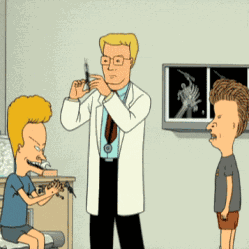Popular culture’s regressive ‘90s retrospective steamrolls ahead this week as MTV puts Beavis and Butt-head (MTV, Thursdays at 10 p.m. ET) back on the couch. Endlessly juvenile, the protagonists have not aged a day. Unchangeable, they have not changed a hair on their distinctive prole pompadours, which are still animated by Mike Judge with deliberate crudity. Judge has long said that he ended Beavis and Butt-head (in 1997, after seven seasons) because he wanted to stop before he had “run it into the ground.” But it’s never too late to start.
The headbangers perch on the same ratty sofa in front of the same boxy TV set. With their bony knees pointed tubewards, they deliver analyses of MTV programming in the same exuberantly sneering tones. Brunet Butt-head continues to look like the alpha loser in the relationship, taller than his comrade by an inch or so, more jaded by half, and meaner by a magnitude of order. He is still vastly stupid and proud of it but capable of insightful nitwitticisms. Blondish Beavis, obviously still lacking a Ritalin scrip, has not settled down. Restless is he, juddering with hormones, junk food, and a pathological need for Butt-Head’s approval. Just unstupid enough to know his limits, he is capable of fleeting wisdom and occasionally possessed of an endearing sweetness. The dynamics of their codependent comradeship have not changed, and it still seems possible that, in their deeply repressed way, they share a love that dare not grunt and giggle its name.
In the first new episode, riddled by Twilight-time desires, they mistake a homeless man for a werewolf and ask him to bite them, that they might transmogrify into chick-scoring lycanthropes. The gentleman obligingly chomps on their scrawny limbs. Consequently, the boys contract a number of diseases and land in the hospital where, despite being comatose, they chuckle and titter whenever the nurse replaces a catheter. (This is the segment’s most successful joke, hinting as it does that the chuckling and tittering is the only way to determine that the boys are still alive, the whole premise of the series being that they persist in a vegetative state.) The second segment turns on an embarrassing coincidence. As the pair watch the rose-ceremony-type climax of a Bachelor-type courtship championship, Beavis happens to discover a chunk of onion—“some vegetable or something”—among the sludge on his chili dog. He tears up, and Butt-Head spends the next several minutes mocking his companion’s show of emotionality. This may be good for a couple thin giggles if viewed in a dorm-room context.
But what of the morons’ function—historically, their most valuable role—as television critics and social observers? What does it mean that Beavis and Butt-Head have recrudesced at the same moment that Pop-Up Video has bubbled back up on VH1. Are ‘90s liberal-arts majors also experiencing nostalgia for metatextual autocritiques? Tiresome though it is to note, music videos all but vanished from MTV not long after Beavis and Butt-head did, so the boys have had to expand their range. The one music video they explicate in their debut dates to 2003. (Promoting a synthesized pitpat of house music, the clip finds a number of well-lubricated young women performing carpentry tasks. That the ladies wear goggles while doing so is perhaps the only way in which the clip is safe for work. Butt-head notes that they are erecting a structure in his shorts.) Casting their beady little eyes on 16 and Pregnant—“This would be a better show if they showed ‘em actually getting pregnant”—Beavis and Butt-head are in fine fettle.
Even so, the fellas look late to the game in picking at the scab of Jersey Shore. This is the whole point of Jersey Shore, yes, to be the object of couch-potato mockery? Too easy. It should be clear that this Beavis and Butt-head is superfluous. One wonders why Mike Judge—after the success of King of the Hill, after addressing adult concerns in the realist drama Office Space and the acclaimed documentary Idiocracy—is devoting his talents to this hesher rehash. Who is this show for? Teenagers with an anthropological interest in how earlier civilizations lived?
There is—beneath the stale crust of the new Beavis and Butt-head, baked in with the program’s existential outlook—a special grimness. Our pal Dana Stevens was not alone in observing “an almost Beckett-like purity to the tedium of Beavis and Butt-Head’s serenely empty lives.” This is a TV show about stasis. B. and B.’s TV shows static, and a sadness attends to joining them on a journey back in time and nowhere at all.
